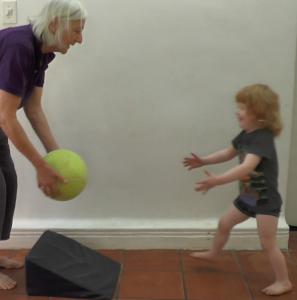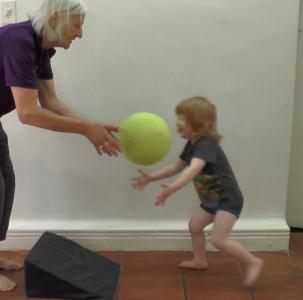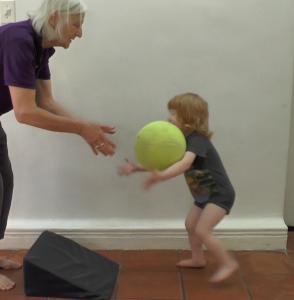Catching a ball, as with other interceptive activities where the hand reaches out to stop a moving object, has several important components that contribute to success:
- Predicting the flight path(trajectory) of the ball and anticipating the best place and time for catching the ball.
- Moving the hand(s) to the right place, at exactly the right time and with the right orientation to grasp the ball successfully.
Predicting the trajectory and velocity of the ball: visual information pickup
Visual information pick-up from two sources allows for prediction of the flight path and velocity of the ball:
- The movements of the person throwing the ball provide important clues, including movements of the head, direction of the gaze, and movements of the arm and hand as the thrower prepares to throw, and then throws the ball.
- Tracking the ball a short distance after it leaves the hand of the thrower
- Shifting the gaze to a position close to the expected point of contact with the ball allows for final on-line adaptation of the path and orientation of the hands
Coordination of movement
In a simple catching action in front of the body the movement sequence is initiated by flexion of the shoulder, followed by flexion of the elbow, with wrist extension and finger extension being initiated as the hand approaches the interception point.
This basic sequencing of the movements of the joints remains the same when to hand(s) are moved to different positions in the space around the body, depending on the flight path of the ball.
Prior to the initiation of the catching action the destabilizing effect of the rapid forwards movement of the arm is anticipated by the postural system, and muscle activity is initiated to stabilize the head and trunk (anticipatory postural responses).
At the same time adaptive balance responses are initiated to anticipate the effect of the movement of the arms on the relative position of the center of mass (COM) so as to keep the line of gravity within the base of support.
Development of catching abilities
Early experience of catching actions
As soon as infants learn to sit independently, they take an interest in reaching towards and stopping moving objects. Balls are often favorite toys.
They are able track a ball that is rolled towards or past them and start to anticipate the direction of the ball that is moving towards one or other side.
This is the start of coordinating the action of the arms and hands with the information they pick up from the environment. They are also learning to anticipate the destabilizing effect of reaching towards the ball on the head and trunk and start to initiate muscle activity to keep these steady.
Young children stopping rolled a ball
As soon as a toddler is standing with reasonable ability to maintain balance when taking a step, and the ability to reach down towards the floor, they start to enjoy "catching" a rolled ball.
They will track a ball that is rolled in their direction, start to anticipate the path the ball will take and start to reach or move towards the ball's anticipated path in readiness for bending down to stop its movement.
This early experience provides good experience in paying attention to important visual cues from the environment. Knowing what to do is an important aspect of any motor skill.
Stopping a rolled ball also provides important experience in coordinating movements of the arm and positioning the hands just right to allow them to stop or grasp the ball. The other important ability that is being practiced is coordinating the movement of the body with visual information.
Young children catching a tossed ball with two hands
Young children's first experiences with catching a ball are when a more experienced partners carefully tosses a ball slowly towards the child who is holding the arms in front of the body with the elbows flexed and ready to catch. The elbows are then flexed and the ball brought to the chest.
With experience the child starts to anticipate the the time to contact as the ball approaches and becomes more effective at successfully catching the ball.
They gat better at catching a ball thrown a little faster and from a greater distance.
Catching a ball between two hands
The next stage is to learn to catch the ball between the hands. Initially young children will position the hands ready for catching, and learn to catch a ball that is tossed towards the waiting hands.
The child is learning to watch the action of the ball tosser, and to track the path of the ball and then moves the hands together to grasp the ball at exactly the right time.
With practice the child learns to move the hands which are being held next to the body rapidly to the interception point at exactly the right time. As this movement becomes more automatic (ie requires less overt attention) the movements of the hands become more automatic and a distinct rapid extension of the fingers is seen just prior to catching the ball.
Initially children are most successful at catching a ball in front directly in front of them, but with practice they learn to catch a ball to the left or right and also at different heights.
Step and catch
The next stage in learning to catch a when the flight path of the ball is outside of the near body space (ie the area around the body that is within reaching distance) and the child has to take one or move steps to be able to intercept the ball.
Step and catch involves integrating the movements of the arms and legs, while at the same time maintaining a steady head and trunk for rapid movement of the arms as they reach out to catch the ball.
Catching in more complex environments
In many activities that involve catching or other wise intercepting a ball the environment is changing rapidly, and the action of the person throwing or hitting the ball is very rapid
This means that there is a great deal of visual information available. Skill in catching a ball in different game situations is all about learning to attend to most important information, interpreting the information (often associated with pattern recognition) and using the information to successfully move towards and and catch the ball.





